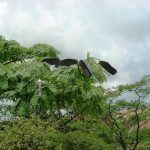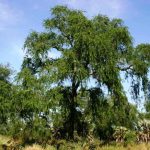TREE LIFE
September 2007
MASHONALAND CALENDAR
Sunday, 16th September. We had originally arranged to go to Thetford Estates. However, owing to circumstances beyond our control we are unable to go there. We have therefore moved the outing to Christon Bank instead, which is nearby and, of course, a very interesting place in its own right. Bart, Meg and I happened to go there on Sunday and although it is very dry, there were quite a few trees in flower and other things of interest to see.
Saturday, 22nd September: Haka Game Park. A return afternoon visit to Haka. Hopefully by late September the vleis will be coming alive with the stunning Spring herbaceous flora.
MATABELELAND CALENDAR
Please contact Jean Wiley or Gill Short for details of the next Matabeleland function.
A New Zimbabwean Botanical Checklist of English and African Plant Names
This book, compiled by our late Deputy Chairman, Lyn Mullen has now been published. Our very great thanks go to the publisher Ian Murphy for seeing it through to fruition and to the Dutch Embassy for financing everything.
The Committee has decided that all paid-up members of the Tree Society as at 1 August 2007 shall be entitled to one free copy of the book. These will be handed out at our outings in future and members will be required to sign and acknowledge they have received their copy.
Only one copy per subscription will be given out. If any member would like to get their copy now, please contact either me or Terry Fallon and make arrangements to pick up their copy.
The book will be on sale generally.
Borrowdale Outing & A.G.M., 20 May 2007
The outing was held at the Borrowdale, Harare property of Mr J Moxon, per kind permission of Mr & Mrs Dave Mason, who made their home and garden available for the annual general meeting, and for this outing.
The property lies at an altitude of 1520 m, about one km north of Borrowdale Center, Harare, just off the Borrowdale Road. The area is flat, with deep red soils. A small seasonal stream forming part of the headwaters of the Umwindsi River runs west to east across the property. Originally the property appears to have been bulldozed, and all indigenous trees were completely eliminated. All trees now growing on the property, including many indigenous trees, were planted, or self-sown after the original clearing. The large group split into two, one group led by Mark Hyde, the other led by Meg Coates-Palgrave.
Indigenous trees
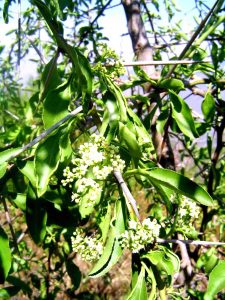
Gymnosporia heterophylla. Photo: Bart Wursten. Source:
Only two indigenous species appeared to be self-established: Gymnosporia heterophylla and Vernonia amygdelena. Planted indigenous trees were: Albizia harveyi, Albizia gummifera, Protea angolensis, Cordia africana, Cussonia spicata, Acacia sieberiana, and Dais cotinifolia. The “Albizia harveyi” had a label proclaiming its name, but did not have sickle-shaped leaflets, and the pods looked more amara-like than harveyi-like. I recently visited an indigenous tree nursery where most of the seedlings were misnamed. In a group proclaiming itself to be Acacia abyssinica seedlings, most had hooked thorns, not spines. Make sure you know what you are getting when you buy indigenous trees!
Exotics
From North America, Liquidamber styraciflua was in splendid autumn display. One tree was a particularly deep red colour. This red colour in the dying autumn leaves is caused by anthocyanins, the same group of chemicals which cause our msasa spring display of new red leaves. An interesting tree is the Honey Locust, named for the sweet pulp within the maturing pods. One book spells the scientific name as Gleditsia triacanthos, another calls it Gleditschia triacanthos. Since the genus is named after Professor Gottlieb Gleditsch, an 18th century botanist, the second spelling should be correct. “Triacanthos” means “three-spined”. As its name implies, the tree is armed with vicious three-pointed spines. Another oddity of this tree specimen was that some leaves were once-pinnate, while others were twice-pinnate.
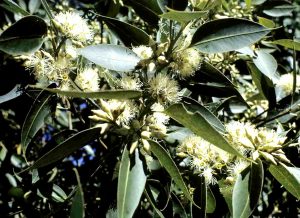
Eucalyptus grandis. Photo: Darrel Plowes. Source: Flora of Zimbabwe
From Australia: Eucalyptus grandis, Eucalyptus cameldulensis, Eucalyptus ficifolia, Grevillia robusta, Melaluca fulgens, and an unknown Melaluca sp. with strongly aromatic leaves. The reason grandis and cameldulensis are such common trees in Zimbabwe is because, for the past 80 years or so, the Forestry Commission has sold these by the million for use as poles and firewood. Eucalyptus grandis, a riverine native from Queensland, Australia, grows best in the moister areas of Zimbabwe. Much of the commercial timber now being sold in this country as “saligna” is in fact grandis.
Escapees: Tithonia diversifolia, Tithonia rotundifolia, Populus deltoides, Salix babylonica (willow), Ligustrum lucidum (privet), Prunus cerasoides, Jacaranda mimosifolia, Toona ciliata. Some of these trees seen were planted, but most are escapees. Tithonia diversifolia and Tithonia rotundifolia, both indigenous to Central America, were believed to have been introduced into Southern Africa in the 1920s in Natal, as contamination in seed packets. In Zimbabwe, they were first reported escaping into the wild in Bulawayo in the 1940s.
Oak trees: Quercus robur (common oak), Quercus palustris (pin oak), and an unknown Quercus sp., with dark green, sandpapery textured leaves. Quercus robur grows widely in Zimbabwe, but suffers from leaf fungus damage. The healthiest trees grow in the cool, moist Eastern Highlands.
Others: Schefflera actinophylla, Jatropha intergerima, both with attractive red flowers.
Meg’s group did leaf identification. Below are a few notes from Meg’s talk:
There are 7 basic types of leaves. A leaf grows on a stem. A stem has a growing tip and a bud in the axils of the leaves. This axillary bud is an insurance against damage to the growing tip. Flowers and fruit never grow on a leaf.
A simple leaf – a blade in one piece. A compound leaf – a blade in more than one piece. The word pinnate means “like a feather”. Parpinnate, or paripinnate—ends in a pair of leaflets. Imparpinnate or imparripinnate—ends in a single leaflet. Bipinnate—a feather on a feather. Trifoliate- three feathers or palmate- five feathers or more. A simple leaf can have a single midrib, or three or more veins from the base.
The leaf arrangement on the stem can be opposite or alternate, or they can be spiraled, one step at a time, or opposite and spiraled, etc.
Coppice growth acts in an atypical manner, e.g. gums, and does not represent the true shape of the mature leaves.
Some leaves have extra-floral nectaries, e.g. Senna, to attract ants, which have a protective interest in keeping other pests away.
Palms: In Phoenix reclinata, the leaflet is bent to form a valley. In Raphia farinifera, the leaflet is bent to form a roof.
Some leaves, e.g. Citrus, have pelucid gland dots, which can be seen when held up to the light. These glands hold oil which give the leaf its typical aroma when crushed.
Thanks to Meg and Mark
-Bernard and Nome Beekes
Ngomakurira Outing, 17 June 2007
The outing was well-attended, and it was a cool cloudless day. Ngomakurira is one of the dominant hills of the Domboshawa area, about 30 km north of Harare. It is a granite hilly area lying in the head waters of the Mazoe River. The soils are reddish, coarse and sandy, recently formed, with little clay or organic content. These soils were very deep at the base of the hill, getting shallower and more rocky as we climbed, and almost completely absent at the higher levels. The relatively flat land lying between the hills is fairly densely populated, and most of the original trees have been cut out, leaving mostly the fruiting trees Uapaca kirkiana and Parinari curatellifolia. Although the hills are relatively well-forested still, commercial and domestic woodcutting is taking an increasing toll on the trees.
On the hill itself, as we climbed to the saddle, and then crossed the bare granite to the stream, we passed through three distinct zones:
Hillside zone.
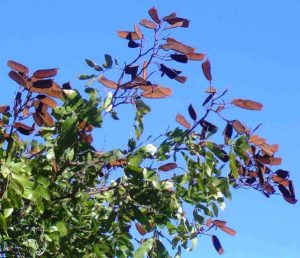
Julbernardia globiflora. Photo: Bart Wursten. Source: Flora of Zimbabwe
This zone itself was in three separate subzones. At the base, a subzone dominated by Uapaca kirkiana, in the middle a subzone dominated by Julbernardia globiflora, at the top a subzone dominated by Brachystegia tamarindoides, the well-known, but re/renamed, mountain acacia. The mountain acacia usually grows on hill tops, or in rocky areas. With its thin bark and its vulnerable root system growing near the surface, often in leaf mould, the mountain acacia is very vulnerable to bush fires, and hence tends to favour rocky areas where fires seldom reach. Two subspecies of Syzygium guineense were seen. Here on the hillside, it was the common subspecies guineense. A notable feature of the day, was that not one specimen of Brachystegia spiciformis was seen.
Bare granite zone.
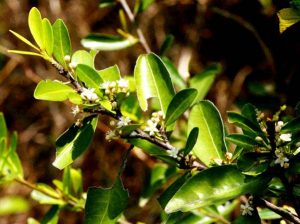
Erythroxylum emarginatum. Photo: Bart Wursten. Source: Flora of Zimbabwe
Plants growing in the very little soil that collects here in the cracks and crevices are very seldom burnt, and here exists one of the unique flora zones in Zimbabwe. Many herbs are endemic to this small area. An eastern highlands special Erythroxylum emarginatum, with its unusual crackly leaves, was exciting. Securidaca longipedunculata, the violet tree, was full of its pinky winged seeds. These seeds change to a straw colour when they are ripe and are ready for wind dispersal. This tree is highly poisonous … particularly its roots, which are used for inducing abortions, or for ritual suicide. A fine large specimen of Peltophorum africanum was nearby.
Riverine. In this type of very rocky area, one of the few places where soil collects is in the steep valleys where the seasonal streams flow. Here the Syzygium guineense subsp. afromontanum was gloriously in flower. Another interesting tree was an Englerophytum magalismontanum, the stamvrug, or stem fruit, with branches full of the light brown bosses, which had borne the edible fruit after which the tree is named.
The whole area was rich in different varieties of trees, as detailed in the alphabetical list below:
Albizia antunesiana; Antidesma venosum; Brachylaena rotundata; Brachystegia tamarindoides; Bridelia cathartica; Burkea africana; Cassia abbreviata; Combretum molle; Combretum zeyheri; Dalbergia nitidula; Diospyros nummularia; Diplorhynchus condylocarpon; Dodonaea viscosa; Elephantorrhiza goetzei subsp.; Englerophytum magalismontanum; Erythroxylum emarginatum; Euclea natalensis subsp. acutifolia; Euphorbia matabelensis; Faurea saligna subsp. saligna; Ficus glumosa; Ficus natalensis; Gymnosporia senegalensis; Heteropyxis dehniae; Hexalobus monopetalus; Julbernardia globiflora; Lannea discolor; Margaritaria discoidea var. discoidea; Mimusops zeyheri; Ochna schweinfurthiana; Olinia vanguerioides; Oxyanthus speciosus; Ozoroa insignis; Pappea capensis; Parinari curatellifolia; Peltophorum africanum; Pittosporum viridiflorum; Protea angolensis; Pseudolachnostylis maprouneifolia var. maprouneifolia; Pterocarpus angolensis; Rhoicissus tridentata; Rhus leptodictya; Rhus longipes; Rhynchosia resinosa; Securidaca longipedunculata; Senna singueana; Steganotaenia araliacea; Strychnos spinosa; Syzygium guineense subsp. guineense; Syzygium guineense subsp. afromontanum; Tapiphyllum velutinum; Tricalysia niamniamensis; Uapaca kirkiana; Vangueria infausta; Vitex payos; and Zanha africana.
-Bernard Beekes
Outing to Jacana Yacht Club Lake Chivero, 17 July 2007,
Jacana Yacht club is located on the eastern shore of Lake Chivero about 40 km west of Harare at an altitude of 1380 m. It lies in a gently sloping granite area with medium-grained, light grey-brown sandy soils. The outing was led by Meg Coates-Palgrave.
There is a stark contrast between the approach roads, where the woodland has been almost totally cut down, and the protected area within the Park boundary. Within the Park, the Miombo woodland has been largely undisturbed for 50 or 60 years which has allowed the understorey to flourish beneath the woodland canopy. Within a small area visited, estimated to be about 5 ha, 64 species of trees were recorded, with 8 species recorded from the Rubiaceae (coffee) family alone. No prizes are offered, but see if you can pick out the individual Rubiaceae species from the detailed list below.
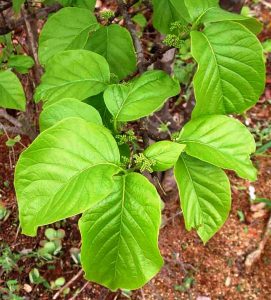
Afrocanthium lactescens. Photo: Rob Burrett. Source: Flora of Zimbabwe
Mid-July is the beginning of the change of seasons in Zimbabwe. Although we do refer to this time of year as “spring”, there is not the well-known northern cycle of spring, summer, autumn and winter. Our deciduous trees do not drop their leaves and then have an extended period of dormancy before new leaves begin. Here the appearance of new leaves follows almost immediately after leaf drop. This cycle of change takes place as the cold dry-season months of June/July turn into the warm and then hot, dry months of August and September. New leaves were seen on Rhus longipes, one of the first trees to get new leaves. Most of the Afrocanthium lactescens trees were full of their characteristic large, about-to-drop, yellow leaves, but one tree was distinctive with new fresh green leaves. On a small granite outcrop was an almost pure stand of Euphorbia ingens. These trees were in full flower and were filled with birds and bees. It is reported that honey from ingens, locally called “noors honey”, is as poisonous as the trees themselves. None of the Msasas, Brachystegia spiciformis, had yet begun leaf-drop. Pseudolachnostylis maprouneifolia leaves were changing from green to red prior to leaf-drop.
In the Zambezi valley, I know Boscia salicifolia as a “willowy” tree, as its name salicifolia (willow-like leaves) implies. Here, the leaves looked very un-willow-like. As Meg said, “What else could it be?”. Around the base of one of the Securidaca longipedunculata were signs that people had been extracting roots, commonly used for abortions and ritual suicides. Olea europaea subsp. africana has changed its name from Olea africana. It is no longer considered a separate species.
Detailed list of trees in alphabetical order:
Afrocanthium lactescens; Albizia amara; Albizia antunesiana; Allophylus africanus; Azanza garckeana; Boscia salicifolia; Brachystegia spiciformis; Bridelia cathartica; Burkea africana; Cassia abbreviata; Combretum molle; Combretum zeyheri; Commiphora mollis; Cussonia arborea; Dombeya rotundifolia; Dovyalis zeyheri; Elaeodendron transvaalense; Euclea divinorum; Euclea natalensis subsp. acutifolia; Euphorbia ingens; Faurea saligna subsp. saligna; Ficus burkei; Flacourtia indica; Flueggea virosa; Gardenia volkensii; Grewia flavescens var. flavescens; Grewia monticola; Gymnosporia senegalensis; Lannea discolor; Monotes glaber; Mystroxylon aethiopicum; Ochna pulchra; Ochna schweinfurthiana; Olea europaea subsp. africana; Ozoroa insignis; Pappea capensis; Parinari curatellifolia; Pavetta gardeniifolia; Pavetta schumanniana; Peltophorum africanum; Protea welwitschii; Pseudolachnostylis maprouneifolia var. maprouneifolia; Psorospermum febrifugum; Psydrax livida; Pterocarpus angolensis; Pterocarpus rotundifolius; Rhoicissus tridentata; Rhus leptodictya; Rhus longipes; Rhus tenuinervis; Schotia brachypetala; Securidaca longipedunculata; Senna singueana; Strychnos cocculoides; Swartzia madagascariensis; Terminalia sericea; Terminalia stenostachya; Tricalysia niamniamensis; Uapaca kirkiana; Vangueria randii; Vangueriopsis lanciflora; Vitex payos; Ximenia caffra; Ziziphus mucronata.
Thank you, Meg.
-Bernard Beekes
REAFFORESTATION IN ETHIOPIA: HAGENIA ABYSSINICA
[The conclusion of a description of one of the indigenous species currently being used in the reafforestation effort for the Ethiopian new Millennium]Part 2
Hagenia also has medicinal uses. Kosso is a drug consisting of the panicles of the pistillate flowers of Hagenia. At the time of the 11th edition of the Encyclopaedia Britannica, the drug was imported “in the form of cylindrical rolls, about 18 inches in length and 2 inches in diameter, and comprises the entire inflorescence or panicle kept in form by a band wound transversely round it.” The active principle, koussin or kosin – C31H33O10, is soluble in alcohol and alkalies. Kosso is also used in the form of an unstrained infusion of the coarsely powdered flowers, which are swallowed with the liquid. It is considered to be an effective anthelmintic for pork tapeworm (Taenia solium) and is similar in its action to Male Fern (Dryopteris filix-mas).
The use of Kosso was borrowed from Ethiopia, where into the 19th century human tapeworm infestation was endemic due to widespread consumption of dishes containing raw beef; frequent doses of kosso, about once every two months, were a common treatment. Richard Pankhurst cites numerous examples, noting that “the two-monthly event virtually constituted a holiday for the patient, who withdrew from all normal activity, the statement ‘the master has taken his kosso,’ being synonymous with ‘he cannot receive you today.’ Kosso-drinking in fact served as an excuse or justification for not keeping appointments, being used by the debtor who did not wish to meet his creditor, by the accused who wished to avoid going to court, and by the official who sought to delay answering the Emperor’s summons.”
Kosso in Amharic is also the name given to the human tapeworm, Taenia saginata. Treatment with Hagenia is often unsuccesful however, resulting in only partial removal of the intestinal worm.
Michel Laverdiere
Obituary Ian McCausland
We regret to announce the sad news that Ian McCausland died on Thursday, 2 August. His death was quite sudden after a long battle with cancer. His funeral (requiem) took place in Bulawayo the following Wednesday, 8 August.
Ian was at one time an active and regular member of the Bulawayo branch of the Tree Society and I have very happy memories of his attendance at some of the longer outings arranged by the Society in the Bulawayo area. I particularly remember his witty and articulate sense of humour. Our sympathies go to his family and particularly his widow Margaret.
-Mark Hyde
MARK HYDE – CHAIRMAN


